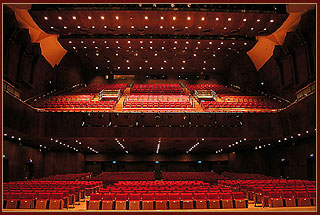Zhongshan Hall
I. Hours of Operation Tue. to Sun., 9:00 a.m. to 5:00 p.m. 
II. Telephone (8862) 2381-3137
III. Web site www.csh.taipei.gov.tw
IV. Address No. 98, YanPing South Road, Taipei, Taiwan
V. Transportation:
(1) Buses: 0 South (right), 0 East (right), 0 West, 9, 12, 25, 49, 52, 201, 202, 205, 206, 209, 212, 218, 221, 223, 231, 232, 233, 234, 235, 238, 239, 242, 243, 246, 249, 250, 252, 253, 259, 260, 262, 265, 281, 302, 304, 307, 310, 601, 604, 624, 628, 701. In addition, the BoAi Road, HengYang Road and Military History Museum bus stops are all within a 5-minute walk.
(2) TRTS Ximen Station, Exit No. 5
VI. History:
On November 26, 1936, the Japanese colonial administration in Taiwan completed the construction of what was then Taipei City Hall. After Taiwan returned to Chinese control in 1945, the building gained a new title, “Zhongshan Hall," and an administrative bureau was established for its management. In 1953 the Officer's Moral Endeavor Association took over management of Hall, which was used for central government celebrations and international conferences. When the Officer's Moral Endeavor Association disbanded in September 1969, Zhongshan Hall was transferred to the Taipei City Department of Civil Affairs, and later to the Department of Cultural Affairs when it was founded in November 1999.
VII. Introduction:
In 1928, the Japanese tore down the Chinese provincial civil administration offices, displaying some of the dismantled buildings at the city's Botanical Garden. At the original site, the colonial administration began building a new Taipei City Hall, a major construction project to commemorate the ascendence of Emperor Hirohito.
Work on Taipei City Hall commenced on November 23, 1932, and took four years to complete, ending on November 26, 1936. The principal designer was Ide Kaoru, an engineer for the Japanese provincial government. The entire project cost D980,000 and required the effort of 94,500 workers.
A four-story steel-reinforced cement structure, Zhongshan Hall was the soundest building of its day, designed according to modern architectural principles to withstand earthquakes, fire and high winds. The grounds measure 44,532 sq. ft., with Zhongshan Hall itself occupying a total of 114,660 sq. ft. Its defining feature was its extremely free architectural form, which made reference to the Moorish style of Spain. In terms of seating capacity, it ranked fourth among Japanese city halls, smaller only than those in Tokyo, Osaka and Nagoya.

![Taiwan.gov.tw [ open a new window]](/images/egov.png)
